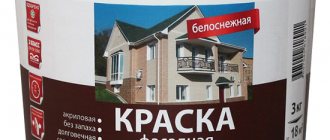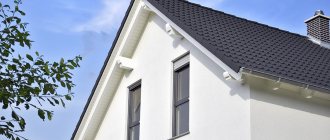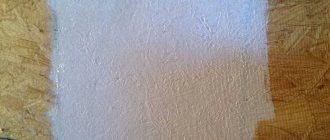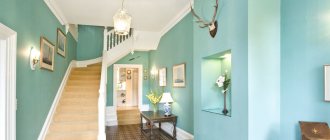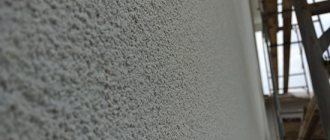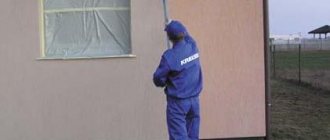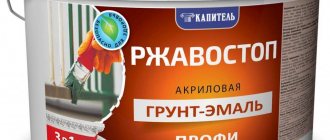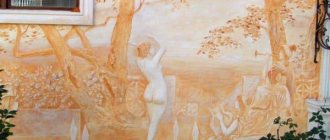Acrylic facade paint - what is it?
Where is paint applied?
In modern construction, acrylic dyes have become widespread - it is actively used by both amateurs and professionals.
Designers especially appreciate the opportunity to embody the most daring creative ideas, builders and finishers like the ease of working with the material, and consumers like the performance characteristics of surfaces treated with acrylic paints.
This type of dye can be used to treat ceilings, walls and surfaces based on wood or metal.
In the vast majority of cases, acrylic paints are used for finishing and decorative work, while hardware stores offer a wide range of materials for processing concrete, brick, wood and plastered surfaces.
Acrylate and acrylic: what is the difference?
Let's look at another nuance: what is the difference between acrylic and acrylate paints. You will see both names on the shelves of building materials stores. Maybe we are talking about the same product, which different manufacturers simply call differently? No, the difference still exists and lies in the addition of specialized chemical impurities: in acrylic paint, the binder is concentrated compounds. No additives or impurities are used. For the production of acrylates, special substances are used: acrylate-copolymer dispersions, which reduce costs and also add useful properties (for example, they increase the permeability of the paint surface to water vapor - this provides a “breathing” effect).
At the same time, the similarity between acrylic and acrylate paints is not limited to just a certain commonality of name: these building materials have a common base and a certain similarity in properties (dry quickly, do not lose shade intensity).
What is the difference between acrylic and acrylate paints?
Reviews: advantages and disadvantages
Experts and experienced craftsmen include the following undeniable advantages of façade acrylic paints:
- environmental safety - no toxins in the composition;
- ease of work - acrylic paints do not have a strong odor;
- fire safety – the absence of flammable components in the composition guarantees the material’s resistance to fire;
- unlimited color palette;
- drying speed - from 1 to 3 hours depending on the thickness of the applied layer;
- Duration of operation of the coating - if all technologies are followed, the coating can last more than 10 years;
- a wide range of applications ensured by the material’s resistance to moisture, mechanical stress and ultraviolet radiation;
- versatility and versatility, which allows the use of acrylic paint in combination with other building materials - the paint can be applied to almost any type of surface, with the exception of only some types of plastic.
Purchase and storage of coverage
On the Internet, on various industrial and construction portals, you can find a lot of proposals for the implementation of acrylic VDK.
Serious companies always guarantee the quality of any paint coating, provide it with reliable storage conditions, and they usually do not have any difficulties with delivery of the goods.
The presence of water in paint components creates some restrictions on storage and transportation methods.
Containers for these purposes must be made of corrosion-resistant materials - stainless or polymer.
VDK cannot be stored at sub-zero temperatures. The permissible freezing limit is no more than 5 times. Transportation is allowed for one month at a temperature of −20 °C, if this can be controlled. This is the only minor drawback for the consumer.
New technologies for the production of acrylic water dispersions make it possible to use their unique properties to coat almost any materials and structures, increasing their resistance to fire and corrosion.
They are not inferior in quality to pentaphthalic paints for painting wooden surfaces, but they dry very quickly and do not have toxic fumes with an unpleasant odor.
This encourages buyers to choose VD-AK and forget about the usual enamels and varnishes collecting dust on the shelves.
Types and technical characteristics of acrylic paint
Acrylic facade paint
Acrylic facade paints come in two types:
- with a base of organic solvents;
- water-based.
Compositions based on organic solvents are ideal for painting surfaces in winter, since even at low temperatures the coating will lay down smoothly and dry well.
The resins, color pigments and other additives included in such paint improve certain properties of the material.
At the same time, water-based acrylic paints consist of acrylic copolymers, polymer additives and special fillers.
After final drying, the resulting coating will not only perform a decorative function, but also protect the surface from the effects of adverse weather conditions and corrosion.
Most often, acrylic dyes for concrete are water-based, but they can also be used for other surfaces, including brick, facade plaster for aerated concrete, and even artificial stones with a porous structure.
Color for wooden facades
Currently, acrylic facade paint is the most popular type of finishing material in Europe - most facades are painted with acrylic paints, and there are a number of good reasons for this:
- high weather resistance and reliable protection of wood from moisture - acrylic coating is resistant to frost and sudden temperature changes;
- preservation of color and shine for a long time, in addition, acrylic paints mix well, allowing you to choose the desired shade;
- good vapor permeability, which allows the wooden surface to “breathe”, freely passing air through it;
- elasticity, allowing the coating not to crack even under the influence of strong deforming factors;
- non-toxic and no pungent odor;
- ease of application - you can use a brush, roller and spray gun to paint a wooden surface;
- quick drying - if it is necessary to renew the layer, preliminary cleaning is not necessary.
Dye for exterior concrete work
Acrylic paints are often used for exterior concrete work. This is due to the fact that this type of coating is durable, wear-resistant and has a high degree of protection.
Acrylic facade paint protects the concrete surface not only from mechanical stress, but also from bad weather and chemical reagents. In addition, it perfectly protects concrete from the appearance of fungus or mold.
The main thing is to properly prepare the concrete base: clean it from dirt and dust, and also remove the old coating.
Acrylic paints for concrete work are easy to apply - in most cases, craftsmen use brushes or a roller.
An additional advantage of this dye is its cost-effectiveness - for concrete surfaces, as a rule, one coat of paint is enough.
Color for walls and ceilings
Regardless of color, acrylic paints are used for almost all types of rooms. This dye can be used both as a main shade and as a means for painting.
Since the product is environmentally friendly and odorless, it can be used even in children's rooms. Even if the child is allergic, acrylic will be an excellent solution for interior decoration.
Due to its resistance to moisture, acrylic coating is also used to decorate the interior of a bathroom or kitchen, however, places subject to frequent splashes (bathtub, sink and sink) should be separately framed with tiles - this will significantly extend the life of the coating.
If you plan to apply acrylic paint in the immediate vicinity of a hob or radiator, then you should purchase a special type of paint that has increased durability.
Paint intended for interior work has a different texture - it can be glossy, pearlescent or matte.
Glossy dye creates a perfectly smooth and shiny coating, but it is recommended to use it only on perfectly smooth surfaces, otherwise even minor irregularities and defects will be noticeable on the ceiling or walls.
Matte paints are distinguished by their great versatility - even over many years they do not lose their quality appearance and are suitable for a wider range of surfaces.
Pearlescent acrylic paint for interior work will allow you to create unique effects in the room and add volume to the texture. Such coatings contain an inorganic filler.
Experts also highlight a product intended for dry and wet areas. Waterproof dye is more durable, but it also costs much more. For this reason, the coating should be selected taking into account the conditions of the room being treated.
VD-AK-2180 VGT GOST
Acrylic facade paint VD-AK-2180 is a white, viscous and oily liquid to the touch.
The main purpose of this material is high-quality painting of ceilings and walls.
Acrylic facade paint VD-AK-2180 is used exclusively for interior decoration of rooms with normal humidity: bedrooms, living rooms and children's rooms, as well as public and industrial premises.
The dye is universal and can be used for drywall, chipboard, fiberboard, wood, brick, concrete, as well as putty and plastered surfaces.
Acrylic façade paint is easily and evenly applied without forming streaks, smudges or splashes, and also effectively masks unevenness of the treated surfaces.
White dye brand VD-AK-2180 diluted with water has a grayish tint, which disappears as the liquid evaporates.
After final drying, the substance forms a smooth matte surface with a whiteness of 83-88%, which remains throughout the entire life of the coating.
Acrylic facade paint is resistant to low temperatures, withstands regular dry cleaning and minor mechanical stress.
The consumption of this paint is 140-160 g/m.
VD-AK-101
Water-dispersed acrylic dye brand VD-AK-101 is a suspension of fillers, pigments and special additives in an aqueous copolymer dispersion.
The paint is intended for brick, concrete, wood, plastered and other porous surfaces. Can also be used to cover indoor surfaces, with the exception of the floor.
Acrylic facade paint VD-AK-101 is characterized by high hiding power, good adhesion and excellent resistance to atmospheric conditions.
The ability of the dye to form a moisture-resistant, but at the same time “breathable” coating allows it to be used in rooms with high levels of humidity. The resulting coating is easy to clean.
VD-AK-101 is applied to the surface using a brush, roller or spray gun at a temperature of at least 8 degrees Celsius.
In this case, the consumption per layer of paint when using a spray gun is 110-130 g/m2.
Technical characteristics of the VD-AK-101 dye are as follows:
- appearance of the film: for VD-AK-101: smooth, uniform and matte surface;
- for VD-AK-101Sh: surface with a silky effect.
- for white paint: no more than 40 microns;
Areas of application
The choice of acrylic paint should take into account the scope of its application. Ease of use has made the composition in demand not only among professional finishing workers, but also among amateurs who independently care for the external walls of buildings or residential buildings. The areas of use are varied and are not limited directly to the construction industry. The main direction is finishing work (final phase), but also:
- design in architecture (embodiment of ideas and projects of artistic orientation);
- treatment of ceilings and walls;
- painting of metal structures;
- processing of wooden elements (from the outside or inside);
- carrying out finishing and decorative works related to the facade of buildings.
There are variants of compositions on sale that can be used on different types of surfaces: painting on plaster (external and indoor treatment), on wood for facades, concrete processing or brick painting.
Painting compositions designed for exterior rust repair are available for purchase. The paint is produced on the basis of an organic solvent or ordinary water. The second option is preferable to choose when finishing will be carried out indoors, since it is less resistant to negative temperatures and changes in humidity.
Painting or restoration work can be scheduled at a time when temperatures pass through zero with a negative value, then the optimal solution would be to choose an organic-based composition. This type of coating fits well on the existing surface and dries quickly. It is recommended to use acrylic paint on water when the main work will be done indoors. It is also used for painting foundations with a porous structure made of concrete, artificial stone or brick. A climate with high humidity will not have a negative impact on the composition and its characteristics.
Acrylic paint GOST 28196-89: technical characteristics
According to GOST 28196-89, acrylic paints must fully comply with the following parameters:
- there should be no “wrinkles”, smudges or peeling on the dried surface;
- level of content of non-volatile components: 52-57% for water-dispersed formulations and 64-67% for solvent-based formulations;
- pH level: 6.5-9.5;
- hiding power: no more than 100 g/m2 for white and no more than 120 g/m2 for other colors;
- resistance to constant exposure to moisture under standard conditions: 24 hours;
- cold resistance: 5 cycles;
- resistance to light: no more than 5%;
- washability: no more than 2.5-3.5 g/m2;
- duration of operation: 10 years;
- drying time: 6-30 hours;
- grinding index: no more than 60 microns.
All of the above requirements are established by GOST, therefore all official manufacturers offer products that comply with these standards.
Water-dispersed acrylic paint
The operational and mechanical parameters of coatings, including water-dispersed acrylic dyes, are regulated by GOST 28196-89.
Moreover, the document is valid not only for acrylate materials, but also for a number of other water-dispersed compositions. In paint markings, the acrylic component is indicated by the letter combination “AK”.
The above standard only regulates properties that are relevant for the interior and exterior treatment of buildings. The quality parameters of artistic paints are not standardized by GOST 28196-89.
Experts include the main technical parameters of acrylic water-dispersed dyes:
- color – determined from a card file of standard colors;
- the appearance of the hardened coating is a homogeneous smooth film;
- the proportion of non-volatile substances, including resins and auxiliary components - their total content should not exceed 47-57% of the total mass of paint;
- pH level – from almost neutral (7.5) to slightly alkaline (9.5).
Also among the most important properties of paint is frost resistance, expressed in the number of freezing cycles that the coating can withstand under standard conditions.
Additional characteristics are: complete drying time, resistance to light and mechanical stress.
Experts consider the following important features of water-dispersed acrylic paints:
- durability of the resulting coating;
- minimum setting time, allowing the next layer to be applied 1 hour after applying the previous one;
- color brightness that does not fade over time and under the influence of ultraviolet radiation;
- low level of toxicity and no pungent odor during operation.
Latex paint or acrylic - which is better: differences
Acrylic paints are universal materials used in almost all areas of construction activity - repair, finishing and restoration of various structures.
Numerous modifications of the dye have a wide range of useful qualities and contain a number of auxiliary elements.
The main difference between latex paint and acrylic paint is the physical and chemical properties and component composition.
In addition to acrylic resins, latex paints contain rubber (latex), which, after the thinner evaporates, forms a more durable and elastic film.
Consumers often equate acrylate and acrylic-based latex mixtures and give them extremely positive reviews.
However, this is not entirely true, since purely latex materials can be used without the addition of an acrylic binder.
Their mutual combination expands the scope of use and the list of performance qualities, but this difference may not be too noticeable to the average user.
As part of these paints, the acrylate base can have a varied composition and contain copolymers - additional chains that modify quality parameters.
The number of available copolymers is quite extensive and covers most of the needs for materials with specific properties.
Common positive properties characteristic of both acrylic and latex paints include:
- durability and strength of the resulting polymer layer;
- color saturation preserved over many years of use;
- UV resistance;
- water-based, ensuring the non-toxicity of the coloring material and the absence of an unpleasant odor during operation.
Adding latex (rubber) to the dye gives it:
- high elasticity, which allows latex paints to be applied over embossed walls and wallpaper;
- aesthetics and visual silkiness;
- resistance to abrasion and moisture - the vast majority of paints are suitable for regular intensive washing, which cannot be said about conventional acrylate compositions.
Thus, the latex component improves the quality characteristics of acrylic, due to which the dye becomes more in demand, but at the same time more expensive.
Properties
Consumption per 1 m2
In each specific case, the consumption of acrylic paint per square meter of surface depends on many factors: the type of solution, the type of facade, the thickness of the paint layer and the proportions between the solvent and the paint coating.
For example, to cover smooth surfaces, dye consumption is minimal. At the same time, for uneven and porous surfaces, paint consumption increases significantly.
As a rule, depending on the type of surface being treated, the consumption of acrylic dye ranges from 300 to 400 g/m2. If the composition was diluted with a solvent, the cost of painting will be slightly higher.
Features of use for facades
The mirror surface of the facade is achieved by covering it with transparent varnish. Additionally, the surface is polished. The glossy effect of the composition is expressed by 5-10%. The applied layer must dry 100% (other layers dry on average ½ day). Failure to comply with the rule leads to the appearance of visual imperfections and defects. Complex work on finishing the facade is carried out with a composition intended for coloring plaster (painting). Dilute acrylic facade paint if it is thick according to the instructions on the package.
Interesting! Acrylic white should not have any tints. A milky tint is not an indicator of quality.
Consumption per 1 m2
In 90% consumption per 1 m2 is no more than 0.5 l, with economical consumption - 0.2 l. Deviations from the norm depend on the number of layers in the painting process. Smooth and even surfaces without distortions or depressions reduce the indicator to 0.2-0.3 liters, porous and embossed surfaces require 0.3-0.5 liters of paint.
Composition and structure of acrylic paint
All components that bind and increase adhesion are present. Tints (pigments with a specific color that help form a tone or shade) are included in all types - the exception is white paint. To create the desired viscosity, the composition contains solvents; they also control the thickness. Fillers add functionality. Additives differ and depend on the purpose of the composition. The structure is homogeneous. Can be thick or liquid. Acrylate paint is used to paint 90% of wood, as it allows air to pass through.
Roller selection
The drum is fleecy or made of foam rubber. It helps to achieve even application on the surface. Artistic work requires the use of a tool with removable attachments. Foam rubber with large cells leaves bubbles. The pile of the main area is 6-18 mm.
Acrylic paint composition
Any acrylic paint contains:
- binder;
- coloring pigments;
- solvents;
- fillers;
- additives.
With the help of a binder, all components of the dye are connected to each other and the degree of adhesion is improved.
The binder component is a material in the form of a polymer dispersion obtained from acrylic resins.
The quality characteristics of the coating, such as service life, strength and abrasion resistance, depend on this component.
What is important is that the quality of the paint directly depends on the type of acrylic resin used, since the binder provides the structure on which the pigment and other additives are located.
As a filler, a composition is used with which the dye is able to cover the surface being treated.
Experts call filler the largest acrylic inclusions that increase the viscosity of the dye, its adhesion to the surface, matting and protective characteristics.
With the help of a coloring pigment, the dye achieves the required color and shade. As a pigment, manufacturers use a finely dispersed powder mass, which does not dissolve in the binder and gives the paint a certain color.
The solvent allows you to reduce the viscosity of the paint, and additives act as auxiliary elements that change its characteristics.
Primer for acrylic paint on wood
In most cases, priming wooden surfaces is a mandatory preparatory step prior to painting.
If painting is required for interior work, then a layer of primer must be applied under the decorative paint or wood varnish for exterior work.
Also, priming cannot be avoided if the wooden structure is located outdoors, which means it is exposed to changes in temperature and humidity levels, as well as infestation by insects and mold.
The situation is the same with unheated or damp rooms, as well as with internal walls in contact with external ones. In all other cases, you can limit yourself to impregnation only.
The main purpose of the primer is:
- neutralization of resins (when using softwood lumber);
- leveling the surface tone;
- waterproofing;
- improving adhesion to decorative coating.
In other words, priming wooden surfaces improves its performance characteristics and saves the consumption of finishing material by increasing adhesive properties.
To prepare a wooden surface for painting with an acrylic composition, experts recommend using an acrylic-type primer.
To achieve the best result, it is recommended to apply the substance in two or three layers.
Distinctive features of acrylic primer are the absence of an unpleasant odor, minimal drying time and the ability to be diluted with warm water. In addition, this type of soil is environmentally friendly, which allows the substance to be used in any room, including children's rooms.
Painting recommendations
Before you start painting, you need to understand whether all the tools are prepared.
- Not only should the acrylic paint be of high quality. A properly selected brush plays a huge role. It is better to choose a brush with synthetic bristles.
- The size of the brush also plays a role. After all, this affects the uniformity of surface coloring. The optimal size is when the width of the brush is 15 cm.
- If you need to paint narrow cracks, then a brush with a width of 2 cm is sufficient.
- Before painting, the brush must be immersed in warm water. This is done so that the brush softens.
- The spray gun is used to speed up painting. In a short time you can paint the necessary surfaces. But they cannot be used to paint transparent paints.
- You should paint only with horizontal strokes.
- Smudges are removed with a squeezed brush.
- The second layer is painted only after the first layer has completely dried.
What varnish should I use?
The main task of varnish is to protect the surface from the negative influence of external factors.
As a rule, mainly wooden surfaces are varnished, thereby preventing moisture from entering the wood and preserving it from external influences. At the same time, varnish is often applied for decorative purposes.
It should be noted that of all types of paints and varnishes, acrylic paint requires the least varnishing.
This is due to the fact that a dye of this type already contains varnish and is excellent at resisting moisture.
That is why covering acrylic paint with a layer of varnish can only be explained by the need to provide the surface with additional protection.
To cover acrylic paint on wooden surfaces, craftsmen recommend using acrylic varnish - in its chemical composition it is closest to the paint itself, and at the same time it is absolutely transparent, which allows you to keep the desired color of the coating unchanged.
Also, the advantages of acrylic varnish include ultraviolet resistance, minimal drying time and the absence of unpleasant odors.
Surface priming
Before painting, the surface must be prepared. When it is cleaned of dust and old coating, a primer is applied. Wooden facades are treated with it to avoid the appearance of fungus and mold. It is recommended to use the primer mixture in rooms with moisture concentrations and in poorly heated buildings. In other cases, acrylic impregnation is used at the preparation stage.
The primer helps neutralize resins on coniferous wood surfaces. In addition, it performs a number of other functions: it acts as a waterproofing layer, the tone of the base becomes even, and the tenacity of the paint and surface increases. Apply the primer mixture in 2 or 3 layers. It is odorless and dries in a short period of time. If there is a need to dilute the mixture, use the liquid in a warm state.
Which roller is best for acrylic paint?
On the question of which roller is best to use for acrylic paint, the opinions of different experts often differ.
Some craftsmen always have several removable attachments in stock and select the appropriate roller model experimentally.
If you look at some training materials, for acrylic paints they recommend using a drum with a coat of short pile or foam rubber, while in the second case it is recommended to attach a specialized attachment to the handle, which will hold the paint flowing down.
A high-quality foam roller is blue in color - this tool is suitable for applying acrylic composition, but the paint will flow down the handle.
At the same time, yellow foam rubber has a highly porous structure and large cells, but after applying a layer of acrylic paint with such a drum, many bubbles will remain on the surface.
Attention: A roller with soft bristles with a length of 6 to 18 millimeters is best suited for applying acrylic compounds.
We can say that you can paint surfaces with acrylic paints using rollers of any material, but preference should be given to a tool whose pile is not subject to caking. A striking example of such a tool is a roller with a velor coat.
Color
Painting the facade with acrylic paints: color combination
The main color of acrylic paints is white, which is why surfaces are most often tinted.
If we are talking about a small surface, and the dye consumption does not exceed 10 liters, you can do the tinting yourself.
To do this, you just need to add the appropriate dye and mix the composition thoroughly.
If a significant amount of work is planned, it would be more correct to select the color at the manufacturer’s tinting station, since this is the only way to achieve the same shade of the composition in all buckets.
Sequence of painting a wooden facade
Unlike a number of artificial materials, wood has the ability to “breathe”. This means that painting work must be approached with particular thoroughness. Let's look at the process step by step.
Surface preparation
Prepare the surface for painting following our instructions.
- Clean the façade from dust, cobwebs and dirt. If necessary, wash the most contaminated areas with soapy water and dry.
- Repair or replace worn parts of the façade.
- Remove layers of old paint and clean the surface.
- Identify areas affected by fungus, treat them with special compounds, or replace them.
- Treat the entire facade with an antiseptic primer and dry.
Select primers and paint of the same tone, preferably from the same company.
Painting work must be carried out at an air temperature of at least 50 degrees Celsius .
The bottom of the facade should be primed especially carefully.
Tinting the white base to the desired color
If there is no paint of the desired tone on sale, you can choose the color yourself by mixing a white base with one or more coloring compounds.
In large stores, this problem is solved with the help of computer programs. You decide on the desired tone, and the program will give you the required proportions. Calculate the required amount of paint in advance so that parts of the facade do not subsequently differ in color.
If no store nearby provides such a service, you can choose the desired tone yourself. To do this you will need a sufficient amount of white base.
When calculating, keep in mind that manufacturers recommend applying paint in at least two layers, so add another 10% to the required volume.
Choose a color on the same basis as the paint itself. To paint facades, select inorganic-based compositions - they are highly light-resistant. To mix, you will need a construction mixer or a drill with a special attachment.
Carry out tinting work in the following sequence.
- mix a test amount of paint in a small container;
- pour 100 ml of white paint into a separate container;
- Add the color drop by drop with a pipette, mixing thoroughly each time and counting the drops;
- Apply the resulting composition to a small area of the facade;
- Allow time to dry to ensure color matches.
- stir the required amount of color in a large container;
- start painting the entire facade.
Colors are produced in the form of liquids, pastes and powders. It is most convenient to work with liquid colors, but powders are somewhat cheaper.
When selecting the desired tone, remember that the amount of color should not exceed 8% of the volume of the white base.
Surface painting
To paint a wooden facade, you can use brushes, a roller or a spray gun. Since acrylic paints dry quickly, be careful when painting. If necessary, pour a small amount of paint into a separate container, and close the main container tightly.
Wash off all blemishes (stains, paint drips) before it dries. During forced breaks in work, tools should be placed in plastic bags or in a container with water. After work, they need to be washed without waiting for them to dry.
Application technology: instructions and video
Features of working with this type of paint
Before starting the painting process, it is necessary to properly prepare the surface - thoroughly clean the walls of dust, dirt and building materials.
After the wall has dried, you need to start priming using a deep penetration acrylic primer.
The standard primer consumption is 100-150 g/m2, however, it is not recommended to save primer, since the further quality of the painting depends on it.
Important: It is best to use a primer from the same manufacturer as the paint.
You can apply the primer in any convenient way - using a roller, sprayer or brush.
However, it is not recommended to use a roller for uneven surfaces. As practice shows, it is most convenient to use a sprayer, but in windy weather the material consumption may increase.
The primer dries from half an hour to several hours. In this case, loose surfaces need to be primed twice.
Once the surface is completely dry, you can begin painting it.
It is important to remember that the paint is temperature sensitive - acrylic dye cannot be used at +5 C and below. If the temperature of the material is below 20°C, it should be heated.
In addition, it is extremely important to pay attention to the date of manufacture of the composition - if the paint has stood for the whole winter, then there is a high probability of it freezing. In this case, the composition will be unsuitable for use.
Application methods
First of all, you need to choose the optimal weather.
It is better to paint the facade in the absence of wind with the thermometer reading from +5°C to +20°C. When working with a spray gun, you should study the recommendations on how to apply the composition correctly. It is necessary to move smoothly, the distance from the sprayer to the wall is at least 20 cm. When choosing a roller as a working tool, work begins from the top corner from bottom to top. It is necessary to watch for smudges. If they form, immediately smear them with a roller, since acrylic paint sets quickly. Paint in 2-3 layers. Each subsequent application occurs after the previous layer has dried.
How to apply acrylic paint?
The algorithm for applying acrylic paint to a surface can be presented as follows:
- surface preparation;
- applying the first layer of paint to the surface from top to bottom;
- drying the first layer of paint in accordance with the instructions (from 3 to 12 hours);
- applying a second layer of paint using a roller;
- painting hard-to-reach places with a brush;
- dry the second coat of paint for 24 hours.
When carrying out interior work, you can ventilate the room immediately - this will allow the coating to dry even faster.
The composition does not like low temperatures and excessively high humidity, so it is recommended to apply the dye in appropriate conditions - a temperature not lower than +5 C and air humidity not higher than 40%.
What should be the basic properties of exterior paint?
Exterior paint must have a formula that is unique in many respects.
Such a building material must demonstrate stability:
- to low temperatures throughout the cold period, from November to March;
- to high temperatures throughout the summer;
- to possible sudden changes in temperature (up to 20 degrees per day);
- to the influence of direct sunlight and high humidity;
- to the action of chemicals (in sediments).
Composition of acrylate materials for painting
How to paint wood correctly?
A special feature of preparing wooden surfaces for coating with acrylic paint is their preliminary priming.
The following videos explain how to properly stain wood:
Price
The cost of acrylic compositions for treating external surfaces depends on many factors, including the region, manufacturer, brand and packaging.
For clarity, let’s present the average prices of the most common brands of acrylic paints:
- “OLIMP” (Russia) – 900 rubles for 5 liters;
- “Tex Profi” (Russia) – 2,700 rubles for 18 liters;
- “Sto Color Opticryl Satinmatt” (Germany) – 6,000 rubles per 10 liters;
- “JUB ACRYLCOLOR” (Serbia) – 6,000 rubles for 15 liters.
Acrylate paints: main manufacturers
Let's look at the main manufacturers of acrylate paints. The buyer should decide in advance which companies produce building materials with a suitable price-quality ratio for you.
The following companies are among the reputable manufacturers:
- "Tikkurila";
- Dufa;
- Teknos;
- "Olivesta";
- Isaval.
Finland is in first place in the ranking of the best manufacturers. The Finns are well versed in painting wooden buildings located in harsh northern conditions - their houses have always been distinguished by bright, rich colors. In Scandinavia, acrylate paints from Tikkuril are the quality standard for painting wooden facades.
Matte acrylate paint Tikkurila Pika-Teho – Pika-Teho
Statistics say that in Scandinavian countries over 80% of all wooden houses are painted with acrylic (and acrylic) paints. The company uses only high-quality raw materials to produce products. If we talk about the shortcomings of Tikkuril, we must admit that the price of paint from this manufacturer is high.
Prices for Tikkurila paints
Tikkurila paints
Video - Tikkurila Helmi - acrylate paint for wood
Canadian is also distinguished by its competent approach to the production of paints and varnishes for coating wooden houses located in the temperate zone. An excellent palette of colors, stability, unsurpassed brightness - all this can be said about Forester. The company also offers a large range of primers and other special materials for treating wooden surfaces. The price of building materials from Forester also cannot be called affordable.
The German company produces high quality acrylate paints. Reviews of their products are consistently positive. For example, white paint produced by , retains its pristine whiteness for many years.
Water-dispersion paint Düfa Expert SILOXAN FASSADE facade acrylate paint, white
There are other, lesser-known European manufacturers who produce paints of consistently high quality; among them:
- VivaColor (Estonia);
- Reesa (Germany);
- Isaval (Spain).
We can also recommend Russian companies that maintain their brand and produce building materials of European quality level. This is Kotovsky paint and varnish, Olivesta.
Dufa paint prices
Dufa paint
Table. Characteristics of acrylate paints from major manufacturers.
| Manufacturing company | Country of origin | Characteristic |
| Tikkurila | Finland | The paints are excellent for harsh climates. Wide selection of shades. Ideal for use on wooden surfaces. Provide super-economical consumption. The downside is the high price. |
| Dufa | Germany | Good performance characteristics. Excellent coating for wooden surfaces. Disadvantage: high consumption, high price. |
| Teknos | Finland | Finnish quality. Easy to apply, forms a smooth matte surface. Economical consumption. |
| Olivesta | Russia | Decent quality. Constant updating of the assortment. Affordable price. In terms of color characteristics, it is inferior to European manufacturers. |
Where to buy acrylic paint for facades?
In Moscow
In Moscow, you can purchase acrylic paint for facades in the following organizations:
- "Bayramix": official website: https://bayramix.ru;
- address: Moscow, 5th Donskoy proezd, building 15с11;
- telephone.
- official website: https://www.isolux.ru
- official website: https://www.dizar.ru;
In St. Petersburg
In St. Petersburg, the following companies sell acrylic paints:
- "Aurora": official website: https://spb-orion.ru;
- address: St. Petersburg, Chugunnaya street, building 4A;
- telephone.
- official website: https://spb-orion.ru;
- official website: https://enkispb.ru;
Thus, it is not for nothing that acrylic paints are the most popular type of paint and varnish materials - they are not only easy to apply, but also create a strong and durable coating without requiring significant financial costs.
Did this article help you? We would be grateful for your rating:

